Self-watering planters might seem complicated at first, but they’re actually quite simple and are made up of only a few parts. If you struggle with over watering or under-watering your plants or travel quite a bit, a self watering planter may be a great option for you!
Or perhaps you’re wanting to conserve water! Self-watering plants do an amazing job at conserving water. Your plant gets water from the bottom of the pot through the plant’s roots so there’s no excess water being drained from the plant.
The plant roots only take in the right amount of water they need from the reservoir system so you’re not wasting water every time you water your plant.
Self-watering planters are great for both outdoor use and indoor plants! There’s so many major advantages of self-water planters. Let’s take a closer look at how self-watering planters work and how you can make one for your own garden!
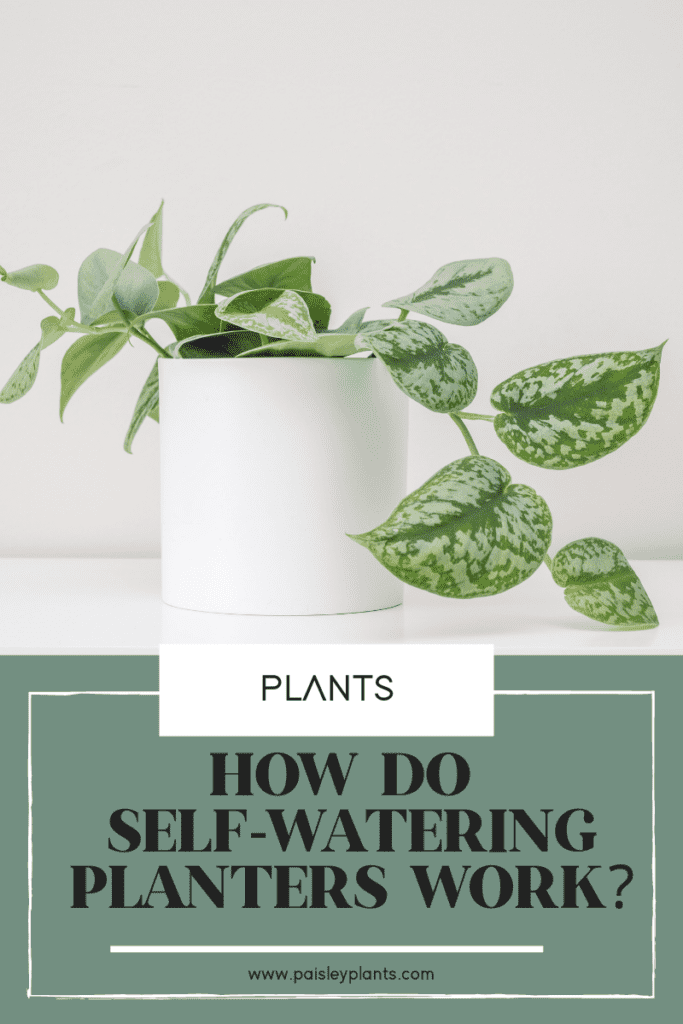
Table of Contents
How Do Self-Watering Planters Work?
Every self-watering planter, no matter how big or small, is made up of four components: the growing bed, the soil, the water reservoir, and the wicking system, a capillary action system.
Altogether, these four components work together to maintain a consistent level of moisture for your plants. Let’s break down these individual components and see what role they play in the inner workings of a self-watering planter.
Growing Bed
This is one of the most straightforward components and needs no formal introduction. The growing bed is simply the chamber in which the soil is held; it is often placed on top of the water reservoir.
In even easier terms, it’s your pot where your plant lives.
Soil
To maximize the functionality of your self-watering planter, you must select the correct soil; not just any potting mix with work with a self-watering planter. The ideal soil for this situation is one that is lightweight and absorbent, the soil must be able to hold in the moisture being delivered to it by the wicking system.
Water Reservoir
Oftentimes, this will be placed underneath the growing bed and must be refilled periodically. The bottom reservoir contains the water supply that the wicking system will use to deliver the water to the soil.
Some self-watering planters have a water level indicator to alert you when you need to refill the container. Some planters will have a small tube above the soil surface where you can refill the water. If this is the case, there will also likely be overflow hole so excess water will drain out and not water your plant too much.
Wicking System
The wicking system is the most crucial component of the self-watering system. The wick is made of an absorbent material that conducts water from the water reservoir up into the growing bed. The water is then absorbed by the soil, therefore resulting in an evenly moist soil for your plants to live in.
What are the Benefits of Self-Watering Planters?
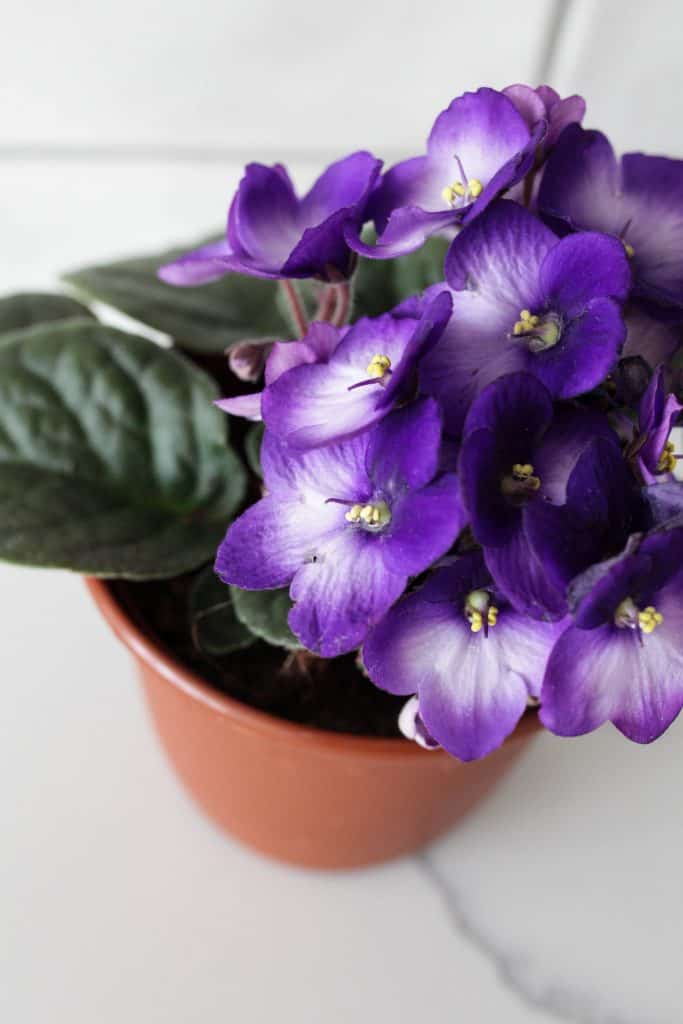
There are 3 major advantages of self-watering planters.
1. Convenience
Investing in a self-watering planter is a great idea for hobby gardeners who struggle to balance their work/home dynamic. I understand that work and travel and let’s be honest, life in general gets in the way of remembering to water your plants.
A self-watering planter takes this responsibility off of your hands, freeing up your schedule to focus on other important life tasks.
Whether you have a green thumb or a black thumb, these planters can be beneficial for anyone with a potted plant or two!
2. Plant Health
One of the leading causes of death in plants is improper water levels. There’s no shame in it; gardeners of all skill sets struggle to maintain a balance in between over and under-watering their plants.
Over-watering can make your plants prone to fungal diseases and bacterial disease, while under-watering deprives plants of nutrients and stunts their growth progress.
A self-watering planter’s purpose is to provide a steady stream of water, only giving your plants exactly the amount they need for optimal growth. In addition, since self-watering pots water from the bottom-up through the plant’s roots, they encourage deep root growth; which leads to healthier, more fortified plants in the long run.
3. Water Conservation
By utilizing a self-watering planter, you are optimizing the amount of water used to hydrate your plants. As we’ve said previously, the self-watering pot is meant to give your plants the perfect amount of water; no more, no less.
Overwatering is eliminated by using one of these planters, which results in using less water.
How to Use a Self-Watering Planter
Self-watering planters are very straightforward and easy to use; approach it as you normally would with any other planter.
- Transfer your plant into the grow bed, use as much soil as you need for your plant to feel comfortable.
- Pour water into the water reservoir. Oftentimes there will be a pipe that allows you to fill the reservoir. The reservoir will have a meter or a viewing window which allows you to monitor the water level.
- Make sure that you occasionally check the water levels in the reservoir and refill when needed.
- If you live in a humid, rainy climate, please keep your self-watering planters inside the home. The excess moisture from the climate will result in waterlogged soil, as opposed to the moist soil you’re aiming for.
Which Plants Work Best with Self-Watering Planters?
Any plant that enjoys living in a soil that is consistently moist will work best with a self-watering planter. Some examples of these plants include baby’s tears, Boston ferns, peace lilies, and even lettuce and herbs can benefit from a self-watering planter.
Do Self-Watering Planters Cause Root Rot?
Self-watering planters do come with some disadvantages. Not every type of plant is compatible with a self-watering planter. Some plants require a soil that periodically dries out, and this is the opposite of the self-watering planter’s purpose.
Plants such as succulents, tropical plants or orchids require their soil to dry out in between waterings. Consistently moist soil with certainly lead to root rot in these types of plants.
For this reason, they are incompatible with self-watering planters. Instead, plants of these varieties should instead opt for a terra cotta planter with a drainage hole at the bottom of the pot.
Three Best Self-Watering Planters
This post includes affiliate links.
After reading all about the benefits of a self-watering planter, you’re probably trying to decide which one you should buy. Allow us to give you some suggestions! These are our top three best self-watering planters.
1. The Lechuza 15222 Cubico Cottage
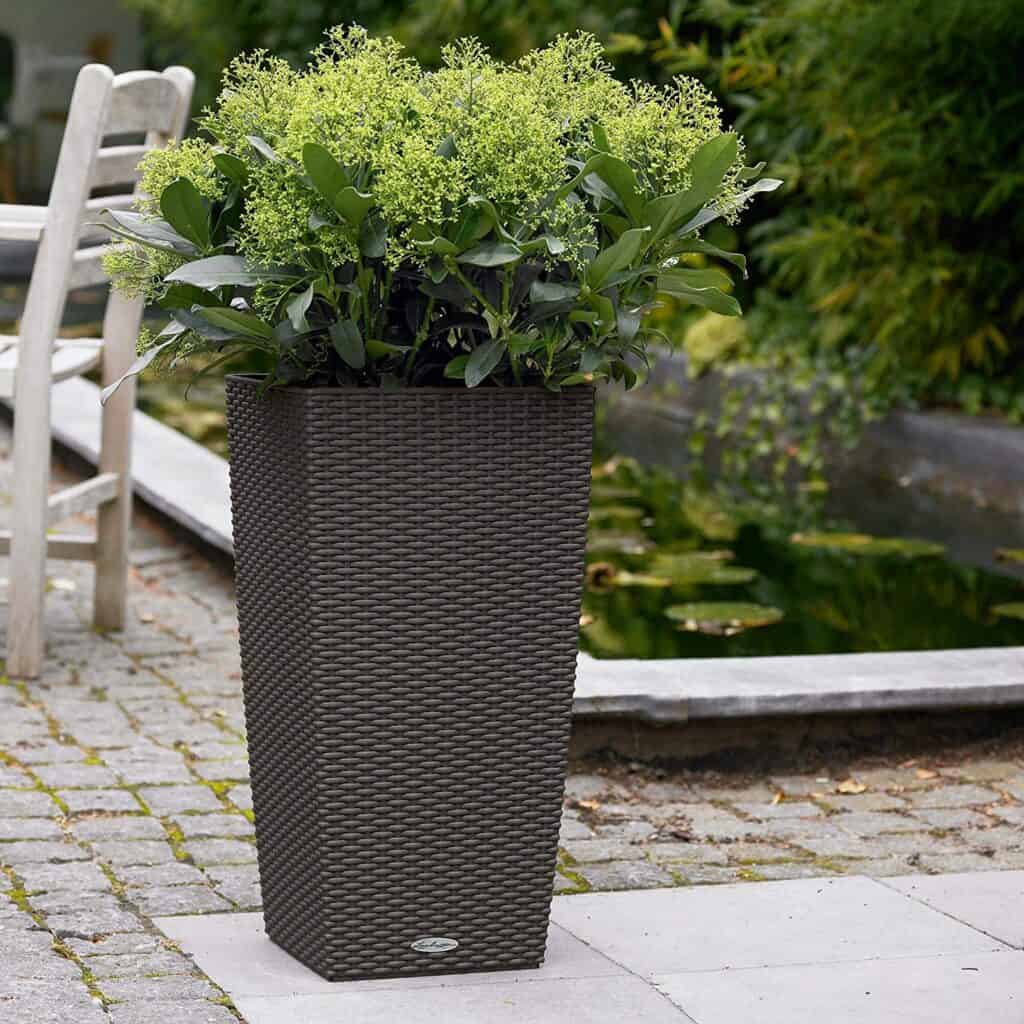
The Lechuza 15222 Cubio Cottage is the best overall self-watering planter. Suited for both indoor and outdoor usage, this planter has a stylish design that is available in three colors. Its dimensions are 12”x12”x22”.
This planter is made from durable plastic that is both frost and UV resistant. It even includes a water-level indicator so you can easily check if the reservoir needs to be replenished.
2. Mkono 3 Pack Self-Watering Planter
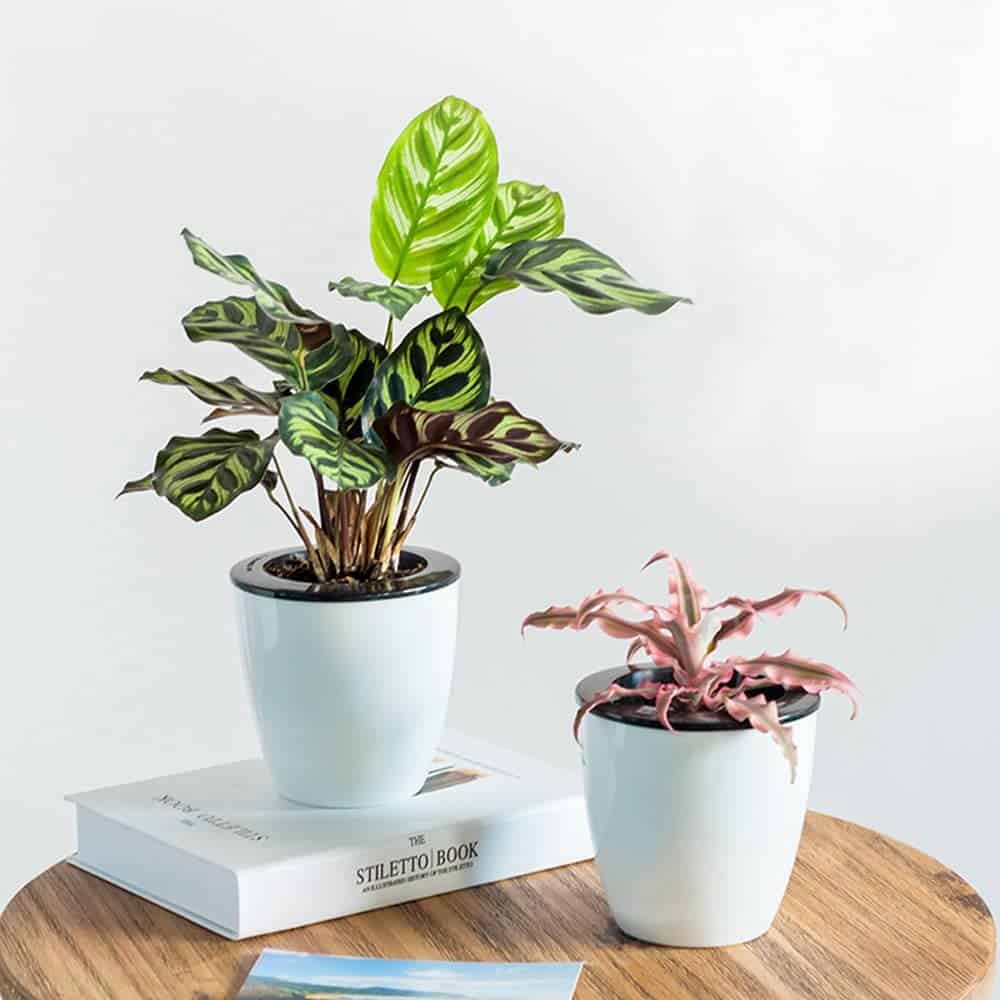
When you choose the Mkono 3 Pack Self-Watering Planter, you’re really getting the best bang for your buck. These planters come in a package of three self-watering pots. These planters are made from durable plastic that is suitable for indoor and outdoor usage.
They are rather small planters, so this would work perfectly for your smaller plants, such as the African violets; their large size is 5.8” in diameter and 7.8” in height. The Mkono planters come in a very stylish black and white design, so it won’t clash with your home decor if you’re a stickler for interior design.
3. Hydrofarm GCTR Grow System
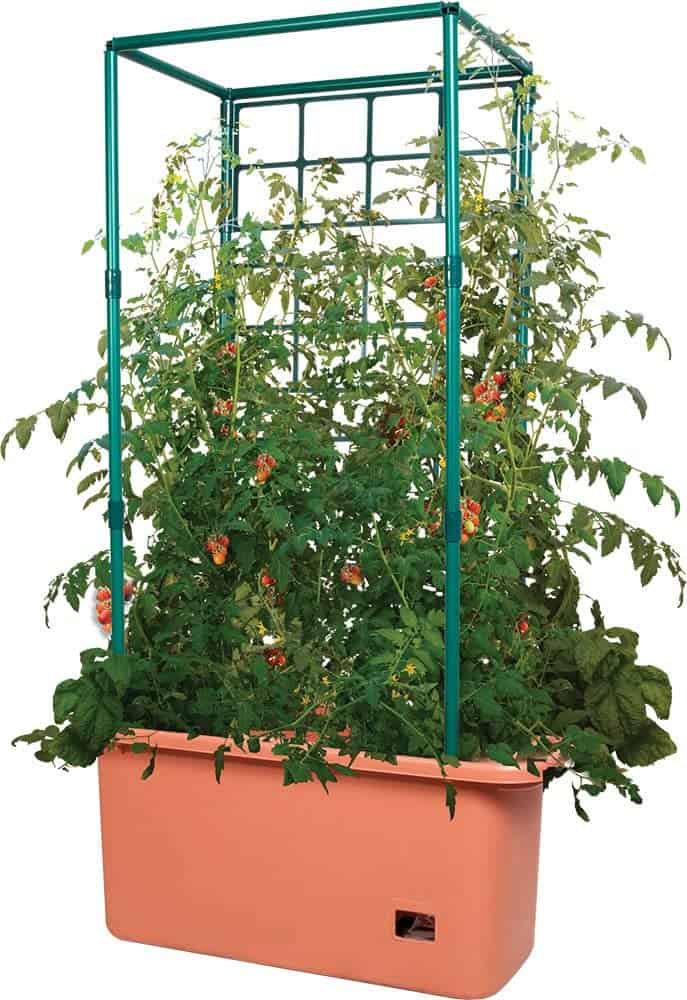
Perfect for growing crops such as tomatoes, beans, squash, or cucumbers, the Hydrofarm GCTR Grow System is a self-watering planter that comes with a built-in trellis.
Capable of holding 10 gallons of soil in its garden bed, this is a must-have if you grow vegetables. This is a great space-saving planter, ideal for those gardening in small spaces such as apartment balconies.
Can I DIY a Self-Watering Planter?
Yes, you can DIY self-watering planters using simple materials you have laying around your home. In order to make your own self watering planter, you just need to replicate five components of the self-watering planter.
You will need:
- A Garden Bed/Plant Pot: A regular plant pot with at least one hole at the bottom
- A Water Reservoir: Another planting container that the plant pot can sit on top of. Ideally use larger containers for this but if you have 2 containers that are the same size, simply put something in the bottom of the reservoir container for the plant pot can sit on. This container should have no holes. I prefer something made of a clear material so that you can monitor water levels without having to separate the system.
- A Wicking System: An absorbent material- either strips of cloth or rope will work just fine. You can also use a small container such as a plastic bottle full of soil as your wicking system. This will be our wick that absorbs water from the reservoir and moistens the soil. I’ll explain both methods below.
- Soil: Select a soil that is lightweight and absorbent to retain moisture.
- PVC Pipe: This is how you’ll fill your water reservoir
DIY Self Water Planter with Cloth or Rope
- First start by ensuring the inner pot sits higher up inside the outer container. Make a mark on the outside of the outer pot to show where the bottom of the inside pot rests.
- Create a drain hole at the spot where you marked. This will ensure that your plant does not sit in water, rather excess water will drain out of the drain holes.
- Fill your bottom container with water up to the drainage hole and place the wicking material in the water. Make sure the wick is touching the bottom of the container; this way the wick gets as much water as possible, even when the water level is low.
- Thread your wick through the hole in the plant pot and place the garden bed on top of the water reservoir.
- Fill your plant pot with potting soil and transfer the plant of your choice into the pot.
- Eventually, the water absorbed by the wick will transfer up into the soil, causing the soil to become moist. Periodically check the water levels in the reservoir and refill as needed.
DIY Self Water Planter with Container of Soil
- First start by ensuring the inner pot sits higher up inside the outer container. Make a mark on the outside of the outer pot to show where the bottom of the inside pot rests.
- Create a drain hole at the spot where you marked. This will ensure that your plant does not sit in water, rather excess water will drain out of the drain holes.
- Next flip your garden bed container upside down. Trace the outline of your small container for soil on the bottom and cut out the hole. Add additional holes for drainage for your plant.
- Create many small holes outside the small container (or wicking chamber) to allow water to enter in.
- Next the watering tube. Cut your PVC pipe at an angle at the bottom. Trim it so it sits at the top of pot. Then create a hole in the inside pot so you can insert it through so it sits in the reservoir of water.
- Fill your bottom container with enough water to reach drainage hole.
- Fill your wicking container with soil, firmly packed down then place it (soil up) in the soil.
- Add the PVC pipe into the pot.
- Fill your plant pot with potting soil and transfer the plant of your choice into the pot.
- Eventually, the water will be pulled up the the container.
In Conclusion
If you haven’t already bought a self-watering planter, then you are definitely missing out! A self-watering planter takes the work out of making sure your plants are hydrated. They provide a constant source of moisture for your plants’ soil, resulting in healthier, happier plants.
Not only that, but you can sit back and relax without having the hassle of remembering to water your plants every day. There are countless self-watering planters out there on the market, so your perfect match is out there.
I highly suggest investing in a self-watering planter, you will not regret it!
If you want pots specific for African Violets, be sure to head here! Need a pot for your Orchid? Head here!

